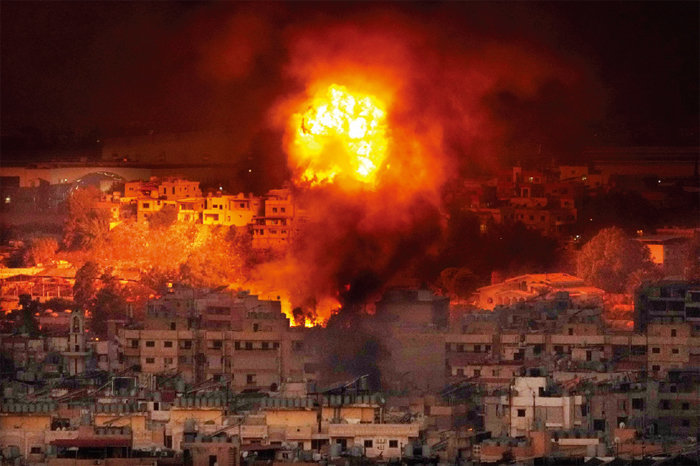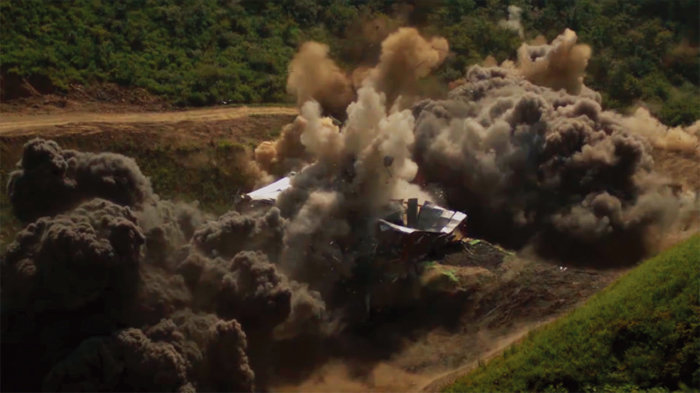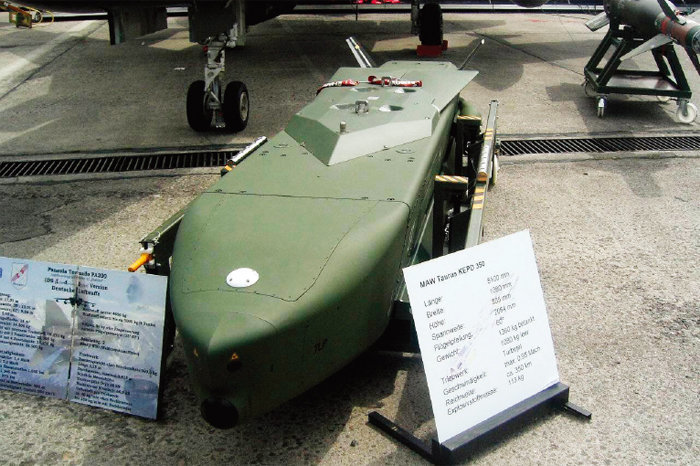North Korea’s ability to strike underground facilities is the highest in the world… We have a large number of monster bunker busters, including Hyunmoo-5.
On September 27 (local time), Israel eliminated Hassan Nasrallah, the leader of the Lebanese armed political faction Hezbollah, through an airstrike after more than 30 years of hard work. Hezbollah established a new leadership within a week by appointing Nasrallah’s cousin as head, but Israel succeeded in removing even this person. The newly launched Hezbollah leadership was eliminated in an airstrike similar to Nasrallah’s on October 4, when it had its first meeting. In two major air raids in downtown Beirut, the capital of Lebanon, residents witnessed ‘carpet bombing’. Dozens of bombs fell within 1 to 2 minutes in a narrow space where several buildings were crowded together. The shock shook the earth so powerfully that people nearby mistook it for an earthquake. It is reported that about 80 to 100 bombs were dropped in each bombing operation. Most of them were special bombs, so-called ‘bunker busters’, designed to destroy underground facilities.
25 Israeli fighter jets ‘carpet bombing’

Typically, carpet bombing is carried out by bombers with enormous bomb payloads. Why was carpet bombing possible even though the Israeli Air Force did not have any aircraft that could be classified as bombers? This is because the F-15I, which has the largest armament load among existing fighter jets, was mobilized in large numbers. Israel deployed its elite unit, the 69th Squadron, into this operation. It is a unit that boasts the strongest striking power in the Middle East, consisting of 25 F-15I fighter jets. In the air strike operation at the time, the F-15I took off with six large 2,000-pound (approximately 910 kg) bombs each. The barrage of bombs launched by about 20 F-15Is could only be described as carpet bombing.
The North Korean leadership probably felt a great deal of fear as they watched Israel’s airstrikes against Hezbollah’s underground facilities. Hezbollah is an organization that has interacted and cooperated with North Korea for a long time. In particular, Hezbollah’s underground facilities were either built directly by North Korea or provided with technology. Moreover, the South Korean Air Force has far more F-15 fighter jets and a large amount of bunker buster weapons than Israel. This means that in the event of an emergency, an operation to strike underground facilities of a scale and intensity incomparable to the recent Beirut airstrike could take place in Pyongyang.
North Korea has long ago built enormous underground facilities across the country following the policy of ‘fortifying the entire country.’ Accordingly, the South Korean military developed and introduced a variety of offensive weapons to destroy North Korea’s underground facilities. Currently, ground-to-ground and air-to-ground weapons are in charge of the bunker buster mission. The Korean military surpasses the Israeli military in terms of type, quantity, and power. In particular, the Korean military possesses a variety of weapons for attacking underground facilities that can be fired from fighter jets. In addition to the small penetrating bomb GBU-39 SDB, it also has the BLU-109 combined guided bomb GBU-31 used by Israel this time. There are many different types, including the GBU-28, which is much more powerful, and the Taurus KEPD 350, which has powerful bunker destruction capabilities despite being a long-range cruise missile. Among weapons launched from the ground, the tactical ballistic missile KTSSM and the short-range ballistic missile Hyunmoo series have bunker buster capabilities. Moreover, the batch quantity reaches hundreds.
To understand how a bunker buster destroys underground facilities, you must first understand the bomb structure and explosion principles. Typically, a bomb is a metal shell filled with powerful but insensitive gunpowder that does not explode easily upon small impacts. Here, a fuse is combined to explode the gunpowder at the desired timing. The types of fuzes vary depending on the purpose of bomb use. Commonly used are an impact fuse (or contact fuse) that operates through physical shock, an approach fuse that explodes by measuring the distance to the target using a radio wave transmission and reception device, and a time fuse that explodes after a certain period of time. There is also a delayed fuse that combines various fuse technologies to explode after a certain period of time after hitting the target. Delay fuzes are often used in bunker busters. This is because the gunpowder inside must not explode while the bomb penetrates the ground.
Bunker buster carried on stealth aircraft secretly strikes North Korean leadership
Bunker busters used today are classified into two types: those that use the kinetic energy of the projectile to achieve penetrating power, and those that install a separate penetrating warhead. The former maximizes kinetic energy by dropping a bomb with a very heavy and hard shell from a high altitude. The higher the bomb launch altitude, the greater the potential energy, which causes the bomb to experience more gravitational acceleration. The penetration power also increases accordingly. The latter is a method that utilizes anti-tank high explosive (HEAT) technology used in anti-tank weapons. When a warhead explodes, the warhead explodes after penetrating the bunker due to the Neumann-Munro effect, in which the explosive force is directed only forward. It is especially effective when breaking through metallic exterior walls such as steel.
The formidable power of the ‘Devil’ bunker buster missile

The Korean military’s aircraft-mounted bunker buster is a falling/gliding bomb that uses kinetic energy. The GBU-39 SDB, which is mounted on several fighter aircraft such as the F-15K, KF-16, and F-35A, is a small bomb weighing only 110 kg. Each F-15K is equipped with 20 rounds, and the KF-16 and F-35A are equipped with 8 rounds each as standard. The bunker buster fired from a fighter jet glides 110km with standard armament and hits the target. If a dedicated penetrating warhead is attached, the glide distance is reduced to 60 km, but it exhibits precision of 1 to 2 m. In this case, the SDB penetrates 1.2m thick reinforced concrete and explodes from within.
The GBU-31, operated on the F-15K, KF-16, and F-35A, is a type of Global Positioning System (GPS) guided bomb called the Joint Direct Attack Bomb (JDAM). It is a model that combines a 910kg BLU-109 penetrating bomb instead of the 2000-pound Mk.84 general-purpose bomb. GBU-31, which flies 31km when launched at a high altitude, penetrates more than 10 to 20m into general soil and more than 1.6m into reinforced concrete before exploding. The BLU-109 has a bomb shell wrapped with 25 mm steel and contains 250 kg of Tritonal, a bomb mixed with TNT (trinitrotoluene) and aluminum powder, showing tremendous destructive power. The BLU-118, a derivative of this bomb, uses a thermobaric warhead. If it explodes at the entrance of a tunnel, it instantly creates a particle cloud inside the tunnel and then causes a huge explosion, causing the entire tunnel to collapse.
The GBU-31 equipped with the BLU-109 is particularly threatening to North Korea. This is because as many as two GBU-31s can be mounted in the weapons bay inside the F-35A stealth fighter, of which the Korean military has 39 units. This means that if South Korea wants to, it can infiltrate the skies over Pyongyang without anyone noticing and destroy the North Korean leadership’s residence with a high-powered bunker buster.
The GBU-28 is a high-power bunker buster developed to strike underground facilities that are difficult to destroy even with the BLU-109. The launch weight is 4,700 pounds (about 2,100 kg), which is more than twice as heavy as the BLU-109 introduced earlier. If launched at a high altitude, it flies about 9km, and because it is laser-guided, it is possible to strike very precisely. It can penetrate more than 30m into general ground and more than 6m into reinforced concrete. Considering that the reinforced concrete outer wall of a typical bunker is 2 to 3 meters thick, this is truly an enormous power.

Unlike the bombs introduced previously, the Taurus KEPD 350 mounted on the F-15K is a missile. This missile weighs 1.4 tons and can fly 500 km. Thanks to the use of a complex guidance device, the accuracy of hitting is also very high. The 5.1m long missile contains a 2.28m long special warhead. The name is MEPHISTO, or ‘Multi-Effect Penetrator, HIgh Sophisticated and Target Optimized.’ It is also the name of the devil that appears in Goethe’s novel ‘Faust’. This weapon, which has truly devilish destructive power, opens the way for the front warhead to pierce 5 to 6 meters of reinforced concrete with chemical energy. Afterwards, the warhead rushes into the bunker and collapses the bunker with an explosion of enormous power.
Just by listing this level of power, we can confidently say that the Korean military has the world’s best ability to destroy underground facilities. But this is not the end. Korea possesses hundreds of monster-level bunker buster weapons. The main character is the various types of ballistic missiles that the Army has. The range of KTSSM, developed to suppress North Korea’s mine artillery, is 180 km for Type 1 and 300 km for Type 2. They are launched from a fixed launcher and a Cheonmu multiple rocket launcher, respectively. While the previously introduced aviation bombs fall on their targets at subsonic speeds, KTSSM hits their targets at speeds of Mach 6 or higher. This tremendous speed leads to powerful penetrating power. Although the military authorities have never announced the KTSSM’s exact penetration ability, if you look at the video of the underground facility destruction test, you can see that it penetrates tens of meters and destroys a huge underground tunnel with a thermobaric warhead.
The unprecedented monster missile Hyunmoo-5
The power of the Hyeonmu series is even more surprising. The Hyunmoo-2B, with a range of 500 km, has a warhead weight of 1 ton and hits the target at a speed of Mach 7 or higher, and the Hyunmoo-4-1, with a range of 800 km, has a warhead weight of 2.5 tons and hits the target at a speed of Mach 9 or higher. The exact penetration power of these weapons is not known, but the prevailing prediction is that they will penetrate 100-200m of general soil, and that they will penetrate more than 20-30m of reinforced concrete. The South Korean military is not satisfied with this and is also deploying the Hyunmoo-5, a monster missile that can hit a target with a warhead of up to 9 tons at speeds of over Mach 10. This missile, which is known to have the penetration power of a low-yield nuclear weapon, is an unprecedented weapon in human history that can destroy targets 300 to 400 meters underground.
At this year’s Armed Forces Day ceremony, President Yoon Seok-yeol warned, “If North Korea uses nuclear weapons, it could face the end of its regime.” The South Korean military has established an operational plan to pour dozens of rounds of various high-power bunker busters into the North Korean leadership’s hideout in Pyongyang in case of emergency. Although it falls short of nuclear weapons, it has already reached the peak of power as a conventional weapon. How long can the North Korean authorities remain relaxed in the face of such a massive bunker buster?
Shin In-gyun, CEO of Independent Defense Network
Source: www.donga.com


